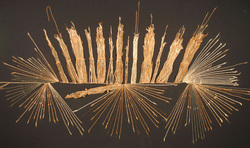Inca Khipu: Anthropologists Take a Crack at an Ancient Code
 Inca Khipu
Inca Khipu I just finished putting the final touches on book about PreColumbian cultures of South America for Buoy Point Media. What was one of the most interesting things I learned while writing?
The Inca used knotted strings as a record keeping system. Called khipu, strings of different lengths and colors could be combined together to create a complex, multilevel record system. Each knot might have a different meaning depending on where it lay on the string, it's relationship to other knots, and even the direction in which it was tied.
What kinds of information did these knots record? Most likely they were used as a numerical system to keep track of goods and services--a sort of cloth spreadsheet. They may have also represented the calendar dates of important events--the birth or death of an emperor, for instance. Beyond that, however, the khipu many have had even more detailed and complicated meanings.
Unlike the Aztec and Maya, the Inca never developed hieroglyphics or any other formal system of writing. The Spanish, who conquered the Inca in 1533, preserved a few khipu but seemed to have little interest in their use. After all, what were a bunch of knotted strings compared to the beautiful textiles, pottery, and gold ornaments for which the Inca were famous? Only about 600 original Inca khipu are known to exist today. For hundreds of years those khipu were confined to remote display cases or left boxed on shelves in museums.
Enter Gary Urton, a Harvard based anthropologist and expert on Inca civilization. After studying many khipu, he began to believe that the knots were more than just a numerical system. They represented a unique and highly developed code. They were, in essence, a form of writing. In 2002, Urton published Signs of the Inka Khipu: Binary Coding in Andean Knotted String Records, a book elaborating on his theories. He also established the Harvard Khipu Database Project. Bringing together anthropologists, archaeologists, computer programers, mathematicians, textile conservators, and historians, the Project is an ongoing effort crack the code of the Inca. By entering information on all known khipu, the researchers hope to not only prove the knots were a genuine written language, but also to reveal what that writing tells us about the people who tied those knots so long ago.
Photo Credit:
Peabody Museum, Harvard University
The Inca used knotted strings as a record keeping system. Called khipu, strings of different lengths and colors could be combined together to create a complex, multilevel record system. Each knot might have a different meaning depending on where it lay on the string, it's relationship to other knots, and even the direction in which it was tied.
What kinds of information did these knots record? Most likely they were used as a numerical system to keep track of goods and services--a sort of cloth spreadsheet. They may have also represented the calendar dates of important events--the birth or death of an emperor, for instance. Beyond that, however, the khipu many have had even more detailed and complicated meanings.
Unlike the Aztec and Maya, the Inca never developed hieroglyphics or any other formal system of writing. The Spanish, who conquered the Inca in 1533, preserved a few khipu but seemed to have little interest in their use. After all, what were a bunch of knotted strings compared to the beautiful textiles, pottery, and gold ornaments for which the Inca were famous? Only about 600 original Inca khipu are known to exist today. For hundreds of years those khipu were confined to remote display cases or left boxed on shelves in museums.
Enter Gary Urton, a Harvard based anthropologist and expert on Inca civilization. After studying many khipu, he began to believe that the knots were more than just a numerical system. They represented a unique and highly developed code. They were, in essence, a form of writing. In 2002, Urton published Signs of the Inka Khipu: Binary Coding in Andean Knotted String Records, a book elaborating on his theories. He also established the Harvard Khipu Database Project. Bringing together anthropologists, archaeologists, computer programers, mathematicians, textile conservators, and historians, the Project is an ongoing effort crack the code of the Inca. By entering information on all known khipu, the researchers hope to not only prove the knots were a genuine written language, but also to reveal what that writing tells us about the people who tied those knots so long ago.
Photo Credit:
Peabody Museum, Harvard University